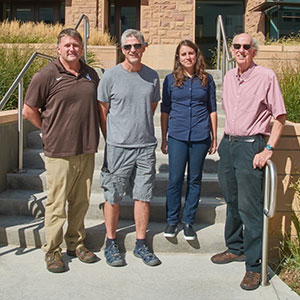Two UW Teams Make National Semifinals of DOE Geothermal Lithium Extraction Prize
Published November 12, 2021

Two University of Wyoming research teams have been named Phase 1 semifinalists of the U.S. Department of Energy’s (DOE) American-Made Geothermal Lithium Extraction Prize, a $4 million competition designed to advance technologies and techniques to support direct lithium extraction from geothermal brines.
The prize is administered by the National Renewable Energy Laboratory and funded by the Geothermal Technologies Office within the Office of Energy Efficiency and Renewable Energy.
Projects led by principal investigators Bruce Parkinson, a professor in the UW Department of Chemistry and the School of Energy Resources (SER), and Katie Li-Oakey, an associate professor in the UW Department of Chemical Engineering, were two of 15 nationwide named as semifinalists. Parkinson’s project is titled “A Selective Membrane for LiOH in One Step,” while Li-Oakey’s project is titled “Goldilocks Ligands for Direct Lithium Recovery Through Surface Engineering and Membrane Adsorption.”
Lithium, a critical material used in high-charge-density batteries for electric vehicles and grid-scale electricity storage, is a crucial element in the clean energy supply chain. Nearly all of the U.S. lithium stock is currently imported. As domestic demand increases rapidly, there is an urgent need to develop safe, secure, domestic and cost-competitive sources of lithium.
“By partnering technology researchers with industry commercialization professionals, the prize will fast-track efforts to recover lithium from geothermal brines at scale,” says Kelly Speakes-Backman, DOE acting assistant secretary and principal deputy assistant secretary for energy efficiency and renewable energy. “These technological innovations will help develop domestic sources of lithium that will create jobs and boost our clean energy revolution.”
Geothermal brines, a byproduct of geothermal power plants, are a promising source of domestic lithium. But there are challenges related to scaling up technologies and techniques in a cost-effective way to recover the lithium while ensuring a minimal environmental footprint. The Salton Sea region of California has the potential to supply 600,000 tons of lithium each year, which exceeds the current annual U.S. demand for lithium.
The Phase 1 semifinalists identified an impactful idea or solution to drive down costs of lithium extraction and, ultimately, help develop environmentally friendly, domestic sources of lithium. Each team will receive $40,000 and is eligible to move on to Phase 2.

“Most lithium is recovered from chloride brines in the form of lithium chloride,” Parkinson says. “The battery makers want lithium hydroxide, so an additional step is needed using an industrial process called the ‘chloralkali process’ that is usually producing sodium hydroxide, hydrogen and chlorine -- all of which are commodity chemicals.
“Our team can make a lithium selective membrane and, so, replace the conventional membrane in the chloralkali process that only lets lithium across the electrochemical cell to the hydroxide producing side of the cell. And, so, you produce LiOH directly from the brine,” he continues.
LiOH stands for lithium hydroxide.
Parkinson’s team includes Jonathan Brant, a UW professor of civil and architectural engineering; and John Hoberg, a UW professor of organic chemistry and organic materials. Both will serve as co-principal investigators.
“Advancing to the semifinals enables my team to focus and expedite our proposed idea of using commercially available membranes to produce an energy-efficient, cost-effective and easy-to-scale module to directly extract lithium from geothermal brine and generate clean water for reuse to minimize waste,” Li-Oakey says.
Li-Oakey’s team includes Christelle Khalaf, associate director for the UW Center for Business and Economic Analysis; Charles Nye, an associate research scientist for the UW Center for Economic Geology Research; and Anastasia Barnes, a second-year Ph.D. student from Wahoo, Neb., in SER. Khalaf and Nye serve as co-principal investigators.
Phase 2 of the competition kicked off last week. Over the coming months, semifinalist teams will advance their Phase 1 proposals to demonstrate their designs’ abilities. Phase 2 proposals are due Feb. 2, Parkinson says. Phase 2 finalists will then fabricate and test their designs for Phase 3.
For a video of the research team led by Parkinson, go to www.youtube.com/watch?v=XBU2NJa0zM0.
For a video of the research team led by Li-Oakey, go to www.youtube.com/watch?v=b1UtHJw50to.

